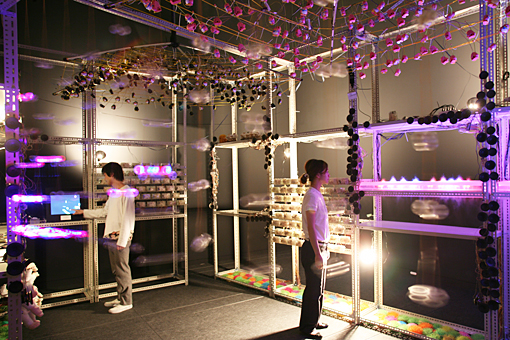"RECONFIGURABLE HOUSE: HACKING LOW TECH ARCHITECTURE"
2007
Usman HAQUE + Adam SOMLAI-FISCHER
 photo: KIOKU Keizo
photo: KIOKU Keizo
There is a "house" that emits light and sound. It is packed with remodeled electronic toys, such as penguin-shaped walkie-talkies and resin-coated cat dolls, hung from the ceiling. A touch screen terminal is installed inside of the house, so that visitors can use it to "reconfigure" the electronic connection between these toys on the software.
In this work, hacking existing low-tech gadgets, new schemes realized by this hacking, and the interactive system are called "architecture." What HAQUE and SOMLAI-FISCHER think crucial is not that the elements of the architecture react to visitors but that "the reacting elements are subject to influence and change themselves." In other words, they aim to achieve an interactivity that is "reconfigurable" to what each user thinks is the best condition. This work is their critique of "smart homes," where users are not allowed to modify a fully-wired IT environment.
* This work reuses the made-in-China censors and gadgets used in the installation titled "Reorient," which was exhibited in the Hungarian Pavilion of the Venice Architecture Biennale in 2006.
The project site "Reconfigurable House: Hacking low tech architecture"by Usman Haque and Adam Somlai-Fischer shows the details of the space at ICC and live sensor values from ICC(during opening hours, and feeds data of "EnvironmentalXML" by Haque. Usman HAQUE (based in London) and Adam SOMLAI-FISCHER (based in Budapest) are architects who have worked on interactive design and projects. They have collaborated in various projects since 2005. What's coherent in their works is the intention to intervene in existing media and demythologize and share technology.
Usman HAQUE (based in London) and Adam SOMLAI-FISCHER (based in Budapest) are architects who have worked on interactive design and projects. They have collaborated in various projects since 2005. What's coherent in their works is the intention to intervene in existing media and demythologize and share technology.
In this work, hacking existing low-tech gadgets, new schemes realized by this hacking, and the interactive system are called "architecture." What HAQUE and SOMLAI-FISCHER think crucial is not that the elements of the architecture react to visitors but that "the reacting elements are subject to influence and change themselves." In other words, they aim to achieve an interactivity that is "reconfigurable" to what each user thinks is the best condition. This work is their critique of "smart homes," where users are not allowed to modify a fully-wired IT environment.
* This work reuses the made-in-China censors and gadgets used in the installation titled "Reorient," which was exhibited in the Hungarian Pavilion of the Venice Architecture Biennale in 2006.
The project site "Reconfigurable House: Hacking low tech architecture"by Usman Haque and Adam Somlai-Fischer shows the details of the space at ICC and live sensor values from ICC(during opening hours, and feeds data of "EnvironmentalXML" by Haque.

Bending
(Circuit) Bending is the act of remodeling existing hardware or software to produce new creations or functions, including errors and malfunctions. Bending refers to a wide variety of acts, from remodeling existing products to reassembling electronic circuits, and to operating software, or combination of such acts. As the Open Source Movement flourished particularly after the late 1990s, circuit bending, in conjunction with the DIY attitude to make media by oneself and the community-like aspect to share individual expertise, has developed into a trend.
